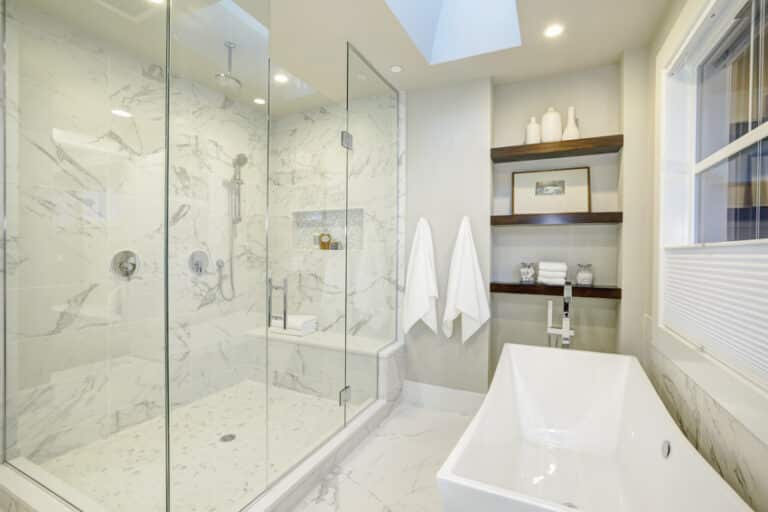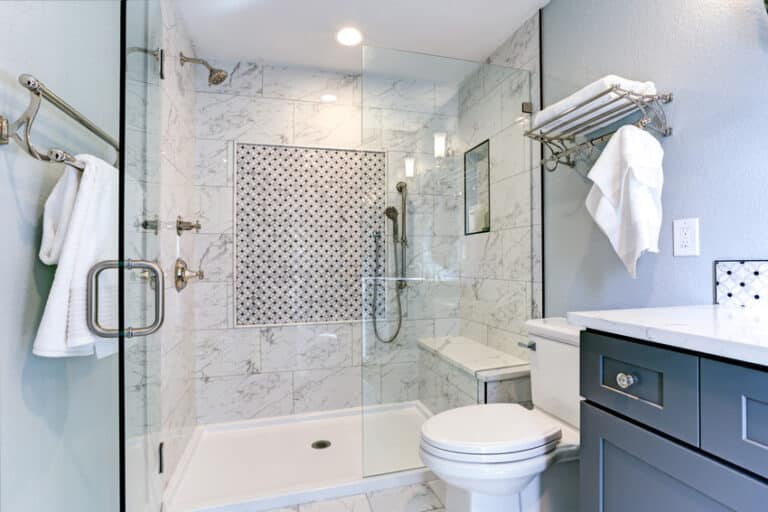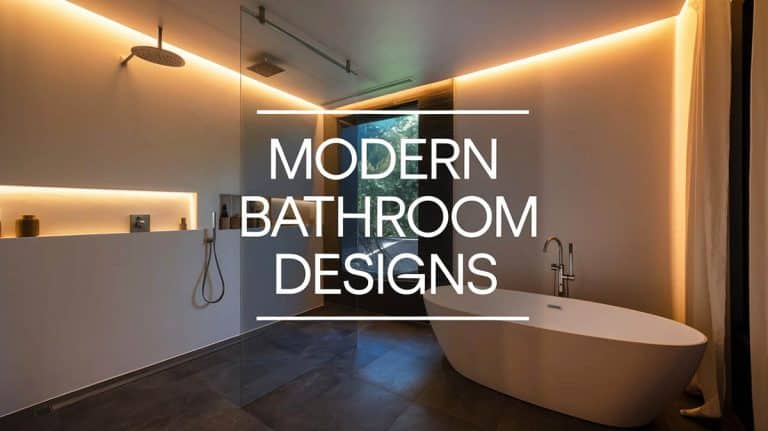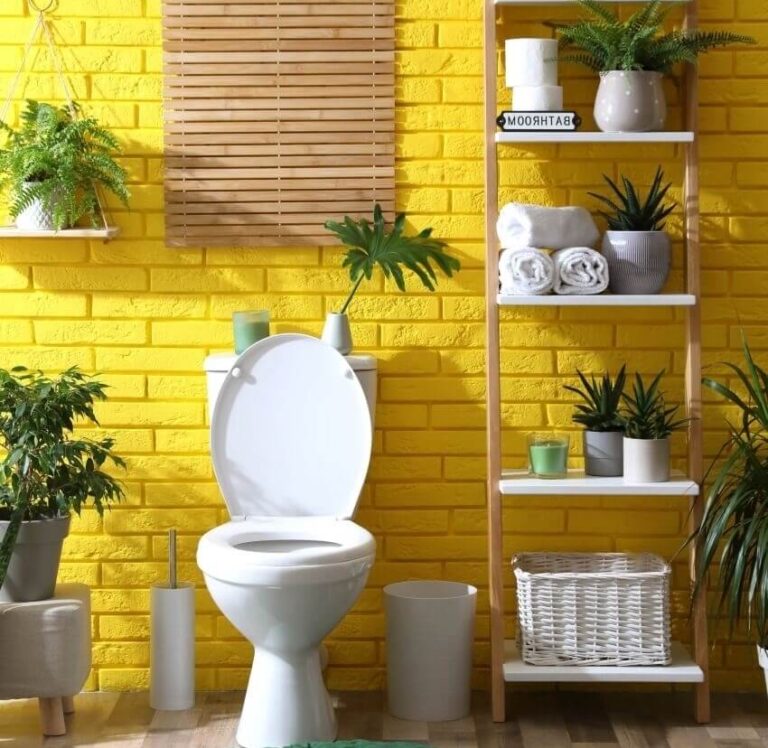Bathroom Lighting Ideas (10+ Types & Designs)
Whether you’re aiming for that Zen experience for your en suite bathroom or a whimsical look for a kids’ bath area, light can set the mood of your built space. In interiors, many types of bathroom lighting can enhance your bathing experience.

We put together bathroom lighting ideas that can enhance and change your space while having that functional and safe lighting system.
Types Of Bathroom Lighting

Here we share the different types of lighting fixtures for bathrooms.
Ceiling Lights
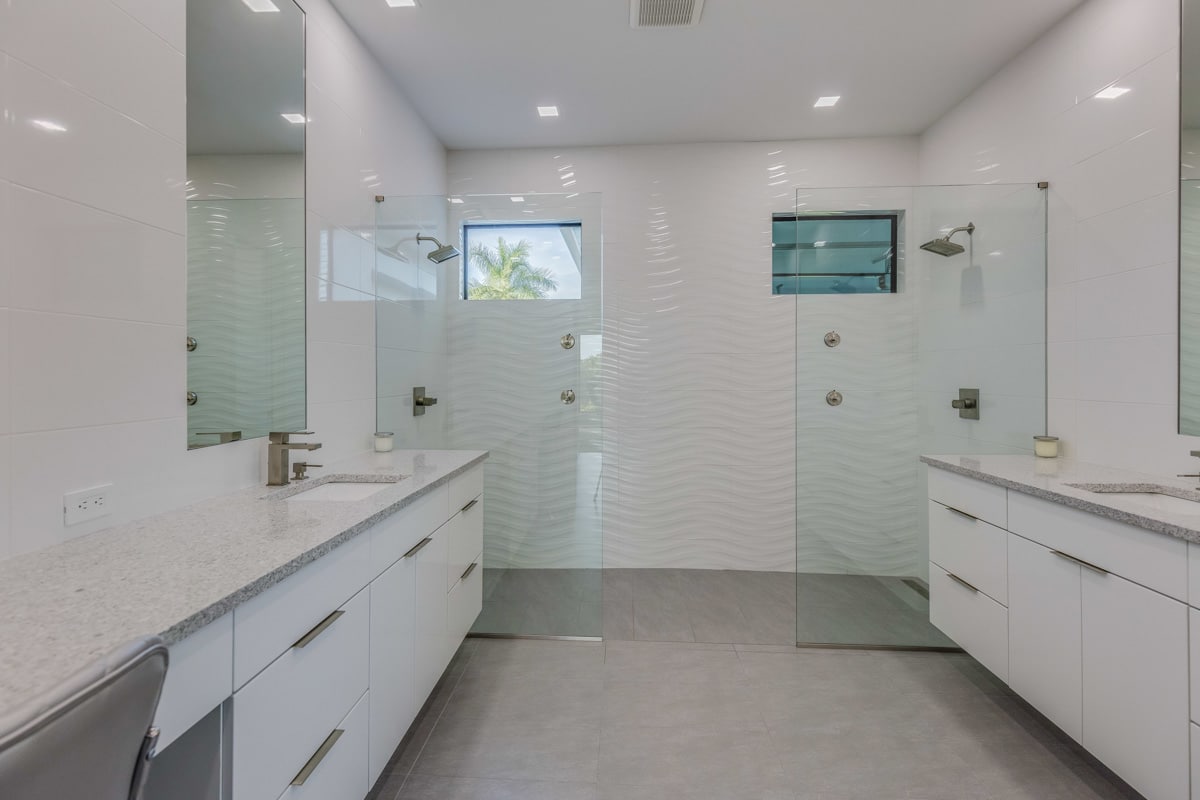
Ceiling lights act as your ambient and bathroom lighting. They set the mood of your space and maintain a light level throughout your room. So, for instance, warm light with a color temperature of 2700 Kelvin, just like your traditional incandescent bulbs, provides a cozy feeling due to the warm temperature.
Lower than 2700 Kelvin, you also get a warm amber hue reminiscent of candlelight. Bulbs with a 4,100 Kelvin temperature are a good choice if you want a lighter and neutral tone. It is not uncommon for bathroom lights to be over-lighted. Due to its tighter space and fewer window openings, the perception is to have a bright ceiling light.
Although, as a guide, you can find the right number of lumens by assigning 70 to 80 lumens per square foot. The 70 to 80 lumens are found in the foot-candle chart, where the area above the sink in kitchens and bathrooms has the highest assigned lumens, with the living and bedroom having the lowest intensity of 10 to 20 lumens.
So, for instance, you have a bathroom that is 8.5 feet in length and has a width of 6 feet:
• Get the bathroom’s square footage/area: 8.5 feet x 6 feet = 51 square feet
• Then, multiply the square footage by 70 lm and 80 lm to get the range = 3,570 to 4,080 lumens
Lux is another lighting unit you can use to find the right ceiling light intensity for your room. For general lighting, 150 lux is assigned.
Opt for dimmable lights and light switches that can control individual areas to prevent over-lighting. Investing in heavy control of lights will help you personalize your lighting experience, which is especially advantageous for multiple users. Remember, though, that other factors can affect your ceiling lighting intensity, and one significant factor is the type of bulb.
LED: Lumens = Watts x 80
CFL: Lumens = Watts x 70
Halogen: Lumens = Watts x 20
Incandescent: Lumens = Watts x 15
Metal Halide: Lumens = Watts x 60
Vanity Lighting

There are three main areas that need lighting in a vanity space. First is your mirror. Vanity mirrors are typically fastened and flushed against the bathroom’s wall, which means you can provide light above or on the sides of the mirror.
New technology allows vanity mirrors to have self-lighting systems such as LED lights, which are built-in mirrors, so they light either behind or upfront. But there are other types of vanity lighting, which include:
Strip or Bar Lights: The sleek appearance of strip or bar lights makes it an attractive option for modern or minimalist bathrooms. The typical light bar is square, commonly having 2 or 3 faces lighted. There are cylindrical versions of the bar light, and as the name suggests, it has a cylindrical profile, which means it has a 360-degree light source and can be fastened with a clip or built-in clamp.
Hollywood Light Bulb: This series of bulbs that are installed at the side of the mirror, usually around or above the mirror frame, is reminiscent of the backstage scenes of movie and theater sets in the past. Reminiscent of the Hollywood glam, as the name implies, it is now mostly made from LED bulbs instead of the traditional incandescent bulbs.
Sconces: Place them on each side of your mirror, or if you have a pair of mirrors for a he and she-vanity, you can place three with one on each side.
Layered Lighting
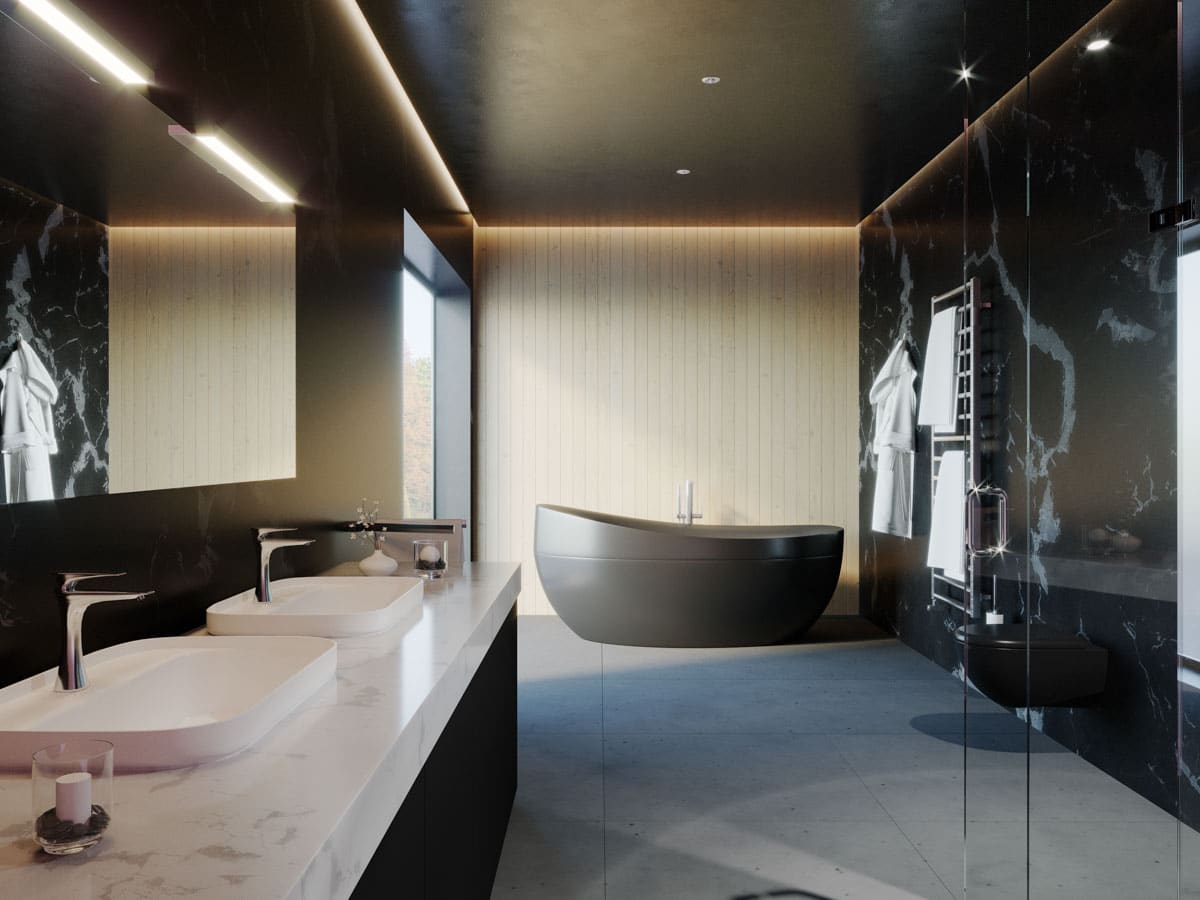
Layered lighting emphasizes the harmonious functioning of different types of lighting fixtures in a space. Bathrooms can be tricky to layer light due to the reflective surfaces since most bathrooms have smooth surfaces in addition to the typical tight space.
What is layered lighting? Layered lighting is a design strategy where the lighting elements are chosen and positioned to create a balanced function and look according to the specified need and preference. Layered lighting involves different types of lighting.
You usually include ceiling, natural, task, and accent lighting in a bathroom’s lighting. The ceiling light is usually called ambient lighting, which sets the mood as discussed previously, but aside from this, you’ll need to consider the task lighting.
Ambient Lights

• Should not cause glare when using the bathroom.
• Natural light should be maximized without sacrificing privacy.
• Create a general illumination to the mood preferred through color temperature.
Common Luminaires Used:
Chandeliers: The opulent ceiling lighting is now a popular fixture in bathrooms as it adds visual interest to the blank ceiling space. Chandeliers are perfect for filling the void of high-ceiling bathrooms and drawing the eyes as they pull together other elements. If you have a spacious bathroom, a chandelier installed in the middle or in a zoned area is perfect for grounding the expansive space.
Cove Lighting: The placement of this diffused lighting around the perimeter of your bathroom sets the atmosphere and feel of the space similar to that you see in commercial spas. The diffused light creates a soft glow, and because it is away from task areas, it doesn’t cause glare, like your vanity space, where the mirror is typically located.
Flushmount Ceiling Lights: A popular shower and bathroom luminaire is the flush-mounted ceiling light. Round white ceiling lights with gold trim are popular because they leave a clean look and don’t take much headroom. This can be used as an ambient light as well as a task light, such as in a shower area.
Track Light: A track light is a series of bulbs encased individually and attached to a track. Each light can be adjusted and oriented in different positions, similar to track lights used in stages in theater or TV production. The track lighting can be the perfect ambient light as the lights can be adjusted according to your preference and need.
Task Lighting

• Cove lights can be used as an alternative to sconces when adding light to the vanity area.
• Consider a 400-lux value for the mirror area.
• Sconces positioned on the sides of the mirror are best for lighting vanity areas.
• As a rule of thumb, place sconces 66 inches or 1.67cm from the finished floor line and 30 inches or .76 cm minimum spacing between each sconce.
• Choose a mirror light that’s around ¾ long as the mirror. This is when placing them above or at the sides so they cover enough area to light and look more visually balanced.
• Consider placing two or three strip or bar lights above for longer vanity mirrors to maintain a balanced look.
Task lighting is used to zone in areas and provide enough lighting when doing tasks. These focused illuminations are designed with need lighting fixtures that are designed to direct light to the surface or area where activities are done.
Adequate lighting is essential in bathrooms as accidents from cutting oneself when shaving or slipping off can happen. Good illumination is also needed when doing make-up or fixing hair. These tasks require focused light provided by luminaires specifically made as task lighting. In bathrooms, task lights usually have a color temperature of 3,000 to 3,200 kelvin.
Common Luminaires Used:
Drop or Pendant Light: A pendant or drop light is a common fixture used in vanities to light up the surface. Because there is a lesser distance between the bulb and the surface lighted, there is more light directed to the work area. Drop-down lights are favored due to the minimal glare they cause in other areas of the bathroom.
Adjustable Lighted Mirror: Most shaving mirrors come with ring lights or LED lights installed on the mirror so you can turn on the light while doing make-up or shaving yourself. Adjustable lighted mirrors will usually have an adjustable arm so you can place it in the best comfortable position.
Track Lighting: This type gives a modern look to a bathroom and is functional in directing light to specific areas on the floor plan. Aside from having track lights that can be individually adjusted, you can also find dimmable track lights.
Recessed Light: Also known as pot light, it is a light fixture that has housing or can be installed between the ceiling and your roof membrane or floor slab. Through a hole, the house or can is flushed into the attic-like space,” creating a clean and sleek look with the can lip only showing.
Because the bulb is encased in a housing, the light source from the bulb is focused in one direction, making it an effective task lighting for your bathroom.
Accent Lighting
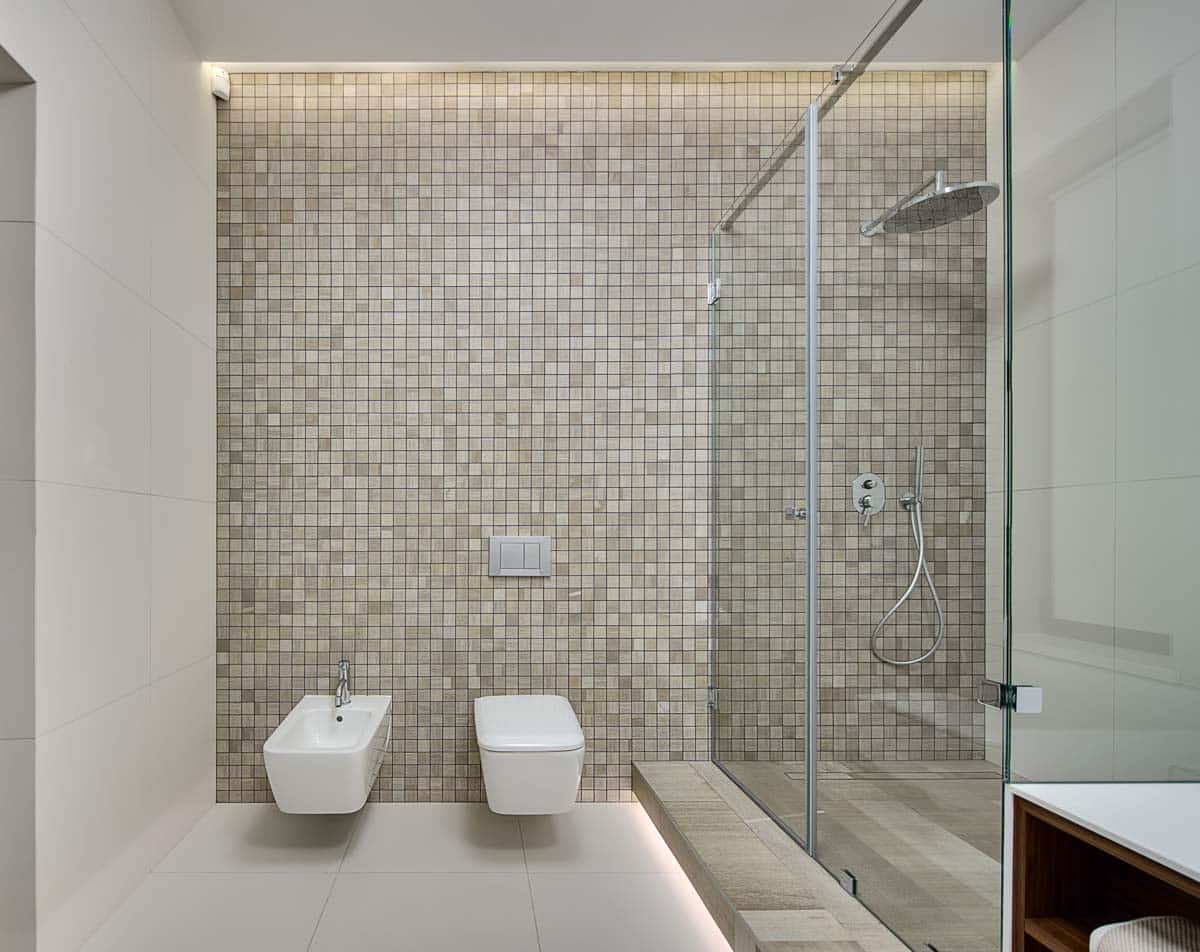
• Accent light not only acts as a visual enhancement but can aid or act as task lighting as it highlights the placement of fixtures, hardware, switches, and other bathroom elements.
• Accent lighting can also highlight décor pieces such as a painting.
Layered lighting is all about achieving dimensional illumination that is functional and harmonious, and accent lights serve as the finishing touches in your design. Although not required, accent lights in the bathroom can enhance architectural features, create shadows and light, draw attention, and add color to the ensemble.
Common Luminaires Used:
Torchere Wall Lamps: This type of lamp has its top open, allowing light to pass through and providing an upward direction for the focused light. This highlights the ceiling and creates an invisible torch of light that fills in the vertical space.
Torchere wall lamps are installed on the bathroom wall, unlike its floor lamp version, which requires shorter vertical posts. If you have an arch or a ceiling feature, you can highlight it by using a torchiere wall lamp.
Bath Bar Fixtures: An alternative to sconces, the bath bar fixture can be used at the sides of a mirror when positioned vertically as well as above a mirror when positioned horizontally. As the name suggests, the luminaire has a bar profile that creates a minimal look, making it perfect for contemporary and minimalistic bathroom styles.
Sconces: One of the most popular types of bathroom accent lights is sconces. Inspired by historical oil lamps, these are fixtures that are typically 5 to 7 inches in width with a wide variety of lengths and designs.
Aside from style, sconces are categorized according to the direction of light. The most common types of sconces are up-light sconces, down-light sconces, candle-style sconces, and half-moon or flush-mount sconces.
Toe Kick Light: Like your hallway lights or stair lights, a strip light is installed along or on the bottom mold of your cabinets as it can highlight the area, which is helpful when all lights are off and can enhance the overall illumination of layered lights.
Shower and Bathtub Lighting
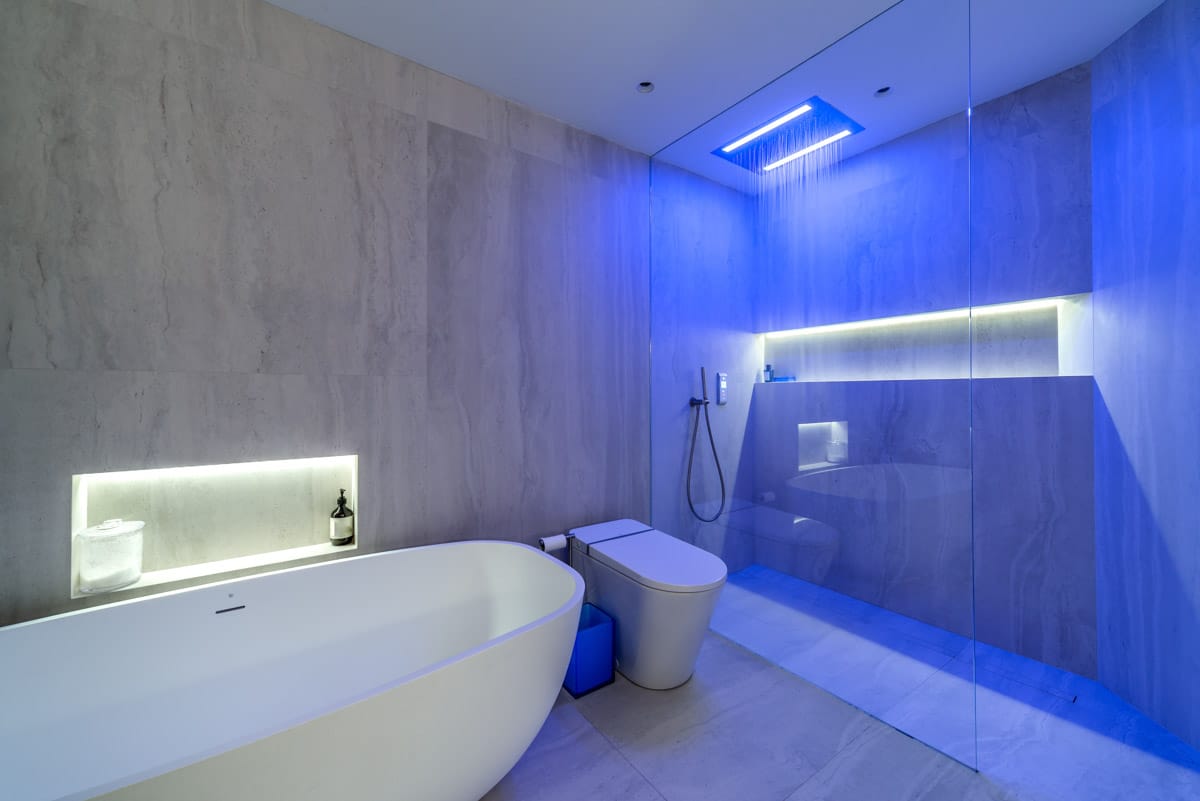
• Pot or Recessed Light: While there is waterproof lighting for bathrooms, there are added advantages of using recessed light as your overhead light in a shower area. Because the bulb and electrical wires are away from moisture and temperature exposure, they are safer and less likely to deteriorate faster. The flushed look also leaves a clean look while having clear headroom, eliminating those protruding lighting fixtures.
• LED Strip in a Wall Niche: A wall niche positioned in a shower area can provide additional light for the shower activity, especially if positioned higher on the wall just below the shower head.
If it is lower, adding an LED strip is still essential as it provides light for the items you place in your wall niche while it acts as accent lighting. You can also find available LED strip kits for shower niches that come with an LED strip, power supply, and a recessed profile.
• Globe Light Sconces: A single or a pair of globe light sconces creates a welcoming vibe in a bathroom, provided you have a high ceiling to prevent obstruction when in use. The globe geometry and translucent bulb can provide dimensional quality to your design, especially if you’re maintaining sleek and clean surfaces.
• Long and Thin Overhead Light: Most shower cubicles have a rectangular perimeter; a long and thin overhead light is enough to distribute general light to your shower area. Add lighting bars on each side of your shower sprinkler or a strip light on your niche.
• Strong Side Lights: If you lack ambient lights, side lights are perfect for providing additional light. Add round lights on the sides up and down reminiscent of a ship bunk window.
Waterproof LED Strip Lights
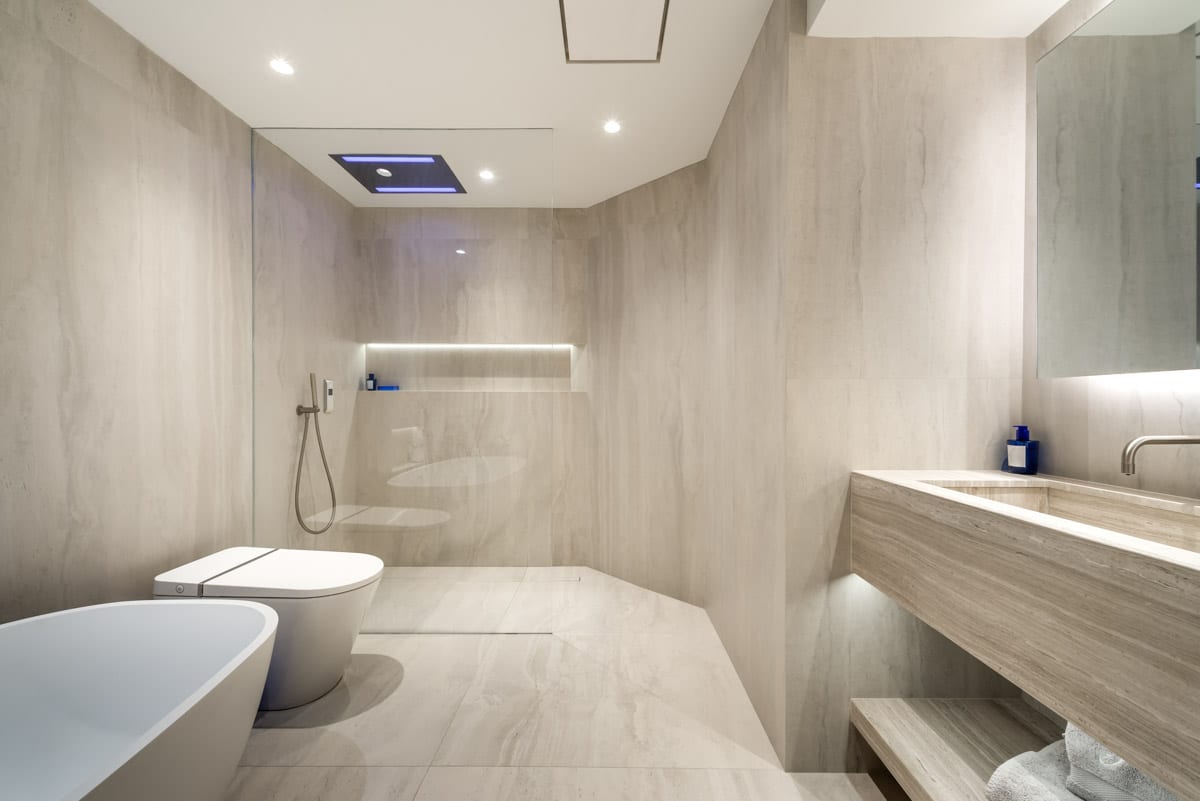
A waterproof LED strip light is needed when installed in bathrooms, and since LED has become the standard lighting in domestic and commercial use, you’ll easily find a waterproof LED strip light.
LED strips are commonly used for cove ceilings and niched walls. If your bathroom also has a drop or recessed ceiling, waterproof LED strip lights are great options as they are easy to install, cheaper than other lights, and can come with dimmable controls.
When looking for LED lights for your bathroom, look for the IP rating on your packaging. There are different types of IP ratings for your bathroom lights. For instance, IP or Ingress Protection rating IP68 has dust protection and can be submerged in water from 1.5 meters up to 30 minutes. You’ll need to seal your connections with a silicone or sealant that has an IP68 rating.
IP20 – Not waterproof.
IP52 – Dustproof but with limited waterproofing.
IP65 – Has better waterproofing and is encased in a silicone tube.
IP67 – Submersible in water and is fully encased with silicone.
IP68 – Completely Sealed and is great for underwater use with a limited time period.
Smart Lighting Systems

One of the benefits of today’s smart lighting systems is the ability to customize your experience according to your lifestyle or preference. Today, a remote controller or even your smartphone can control smart light systems.
Voice-activated lights have been on the market, but added features such as color control, time, and automatic lighting systems that automatically shut down when no movement is detected can also be included.
Bathroom Lighting Innovations
• Light and Shower in One: You’ll find showering during the night as the perfect mood switch as the light and shower in one has an LED light strip installed around your shower sprinkler. Not only is it an immersive experience, but it can minimize ceiling elements, leaving a cleaner and sleeker look in your shower area.
Accent Lighting Ideas
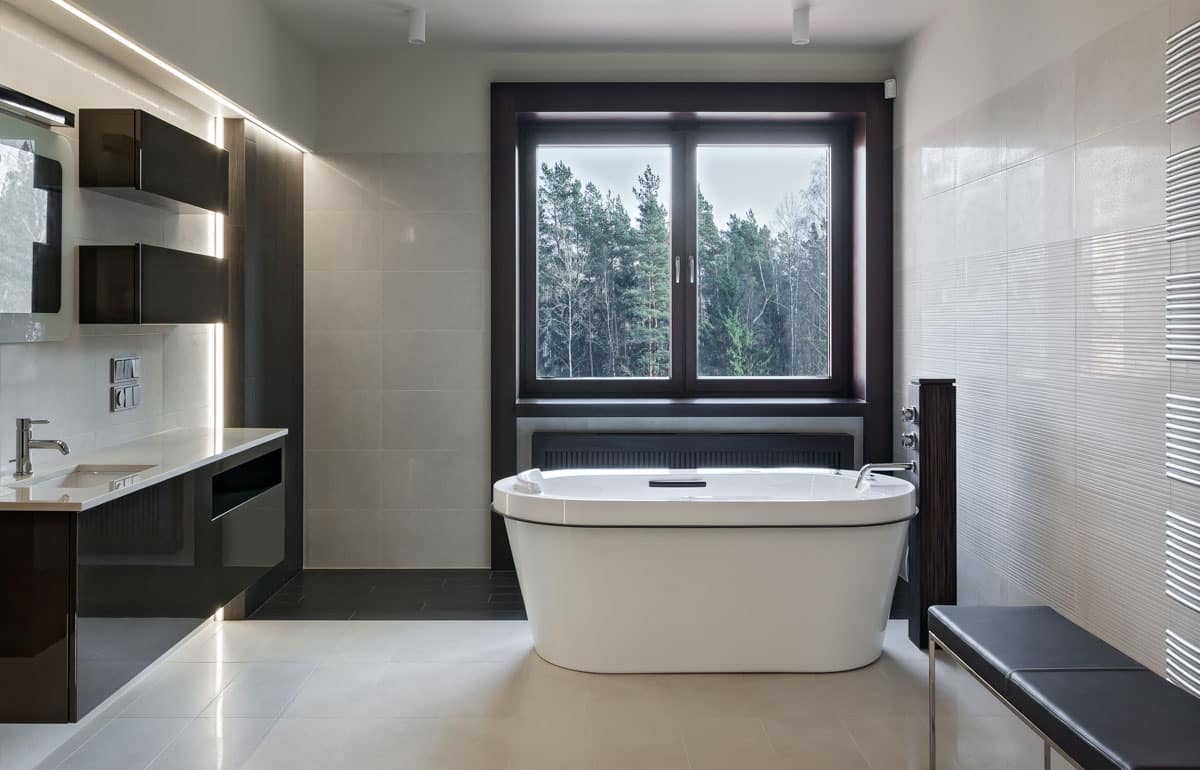
Lighting fixtures can be sculptural pieces as well. The following are a few accent light ideas you can incorporate into your bathroom space:
Triple lighting fixture with gold, black, and white colors: A light fixture with a provision for three bulbs creates balance in your vanity mirror and distributes light better. You can opt for a pair instead if you have a narrower bathroom space. Neutrals and a touch of metallic color work well in a bathroom space. Match your accent color with your planned hardware material to create a cohesive look.
Globe pendant lights are grouped and with different levels: Like drop-down pendants on a loft staircase, globe pendant lights hanging on different levels, either on one side of your mirror or above your vanity, add visual interest. You can choose clear glass bulbs to still allow light and view through your group of lights.
Candlestick lights to replace sconces: While there are a lot of designs available for wall sconces, there’s something familiar with candlestick lights. These fixtures give an instant welcoming vibe in a bathroom, and you can find an electric lighted version that still has that decorative design. Choose metallic finishes such as brass or chrome for a luxurious effect.
Traditional and exotic pendant or chandelier lights: Moroccan light lamps or African-inspired light fixtures can give instant character to your bathroom. Contrast it with a minimalist interior to create a focal point in the room.
A pair of table lamps on your vanity counter: A pair of table lamps can add personality to your bathroom area if you have a deep vanity counter. This unusual fixture in the bathroom should be waterproof for safety, and the wiring should be secured so as not to cause obstruction when using your countertop.
Maximizing Natural Light: The generally accepted bathroom window opening percentage is 3 square feet or .3 square meters with a minimum of 1 window opening. That is approximately having a .6 m x .5 m opening.
If you have a bathroom with a bare minimum window opening, maximizing natural light is essential as it functions as a natural disinfectant, improves the mood of your bathroom, and lessens energy bills.
To maximize natural light in a bathroom, you can:
• Use translucent or thin curtains to still allow natural light to seep through the space.
• Paint walls with light and neutral-toned colors such as off-white or beige. You can choose among the plethora of variations of these colors based on their undertones.
• Use glossy surfaces to allow light to reflect and bounce off surfaces.
• Use translucent materials, such as glass, for shower dividers.
Color Temperature and Mood

A factor when determining lighting temperature is the main function of a room. Bathroom lights for personal use or your everyday en-suite bathroom is 3000 to 3200 Kelvin with a bright and crisp quality. At the same time, your guest bathrooms are best for having a comfortable ambiance, so a warmer light of 2,700 Kelvin is recommended.
Color temperature is not a measure of the surface temperature of an actual lamp or any of its components. Color temperature refers to the absolute temperature of the laboratory blackbody radiator when its visible radiation matches the color of the light source. – Interior Lighting for Designers, Gary Gordon
Color temperature can either be warm or cold. The former ranges on the warmer side of the color temperature spectrum, while the latter is on the cooler side. You can play with these values to either go for coziness or accuracy. If you are just there enjoying the leisure of relaxing in the bathtub, the warm color gives a warmer feeling. But when putting on make-up, you will have to go for white or bluish lights.
The warmer colors can alter your skin color and affect the way you wear make-up. If you can measure your light source’s color rendering index or CRI, make sure it is between 80 and 90. This approximates a white glow or what you would get if you were outdoors on a sunny day. Wear make-up at this CRI range, and what you see is what you get.
• 2000 to 3500 Kelvin – Warm and Cozy
• 3000 to 5000 Kelvin – Neutral and Protective
• 5000 to 6500 – Bright and Stimulating
See more related content in our article about the different bathroom skylight ideas on this page.

